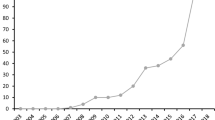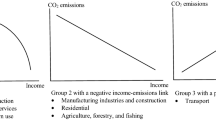Abstract
Innovation is the first power to drive the county’s green and low-carbon. It is crucial to explore the impact of innovation on air pollution from the perspective of counties at the bottom of the administrative division hierarchy. The article is aimed at exploring the direct impact effects, spatial spillover effects, impact mechanism pathways, non-linear relationships, and cost-benefits of innovation drive on air pollution in counties. To this end, based on the collection of county-level data from 2007 to 2020 in mainland China, the article constructs a fixed-effects model, a dynamic panel model, and a spatial Durbin model for analysis. For every 1% increase in the quantity of innovation, the county SO2 emission concentration decreases by 0.2% on average; for every 1% increase in the quality of innovation, the county SO2 emission concentration decreases by 0.3% on average. When the county innovation quantity driver increases by one standard deviation, the county SO2 concentration decreases by an average of 0.29%; when the county innovation quality driver each standard deviation increases, the county SO2 concentration is reduced by 0.33% on average. The significant entry of high-end factors, the increased frequency of regulation by the environmental protection department, and the increasing efficiency of energy use are the important mechanism pathways for innovation-driven reduction of air pollution in counties. There is no significant “(inverted) U-shaped” relationship between innovation-driven air pollution in the county samples. There is a negative spatial spillover effect of the innovation quality drive on air pollution control in all Chinese county samples. Innovation to drive the declining size of the county’s sulfur dioxide can bring about one billion yuan (about 139.81 million U.S. dollars) in comprehensive economic benefits. In the coming period, county governments should build a new pattern of “blue sky and white clouds” with neighboring regions in terms of spatial agglomeration of high-end elements, green transformation and utilization of energy, and intelligent monitoring and supervision of pollution.


Similar content being viewed by others
Data availability
The author has uploaded data to Springer Nature’s Data Support Services.
References
Abbas S, Gui P, Chen A et al (2022) The effect of renewable energy development, market regulation, and environmental innovation on CO2 emissions in BRICS countries. Environ Sci Pollut Res 29(39):59483–59501
Ahmad M, Khattak SI, Khan A (2020) Innovation, foreign direct investment (FDI), and the energy–pollution–growth nexus in OECD region: a simultaneous equation modeling approach. Environ Ecol Stat 27:203–232
Ali N, Hu X, Hussain J et al (2021) Assessing the environmental impacts of COVID-19; a review. Pol J Environ Stud 30(5):4401–4403
Ali N, Phoungthong K, Khan A et al (2023) Does FDI foster technological innovations? Empirical evidence from BRICS economies. PloS One 18(3):e0282498
Ali N, Phoungthong K, Techato K et al (2022) FDI, green innovation and environmental quality nexus: new insights from BRICS economies. Sustainability 14(4):2181
Boudri JC, Srivastava L, Kroeze C (2002) The potential contribution of renewable energy in air pollution abatement in China and India. Energy Policy 30(4):409–424
Chen F, Wang M, Pu Z (2022) The impact of technological innovation on air pollution: firm-level evidence from China. Technol Forecast Soc Change 177:121521
Chen H, Yi J, Chen A et al (2023) Green technology innovation and CO2 emission in China: evidence from a spatial-temporal analysis and a nonlinear spatial Durbin model. Energy Policy 172:113338
Chen J, Wang SJ, Zhou CS et al (2019) Does the path of technological progress matter in mitigating China’s PM2. 5 concentrations? Evidence from three urban agglomerations in China. Environ Pollut 254:113012
Dauda L, Long X, Mensah CN (2019) The effects of economic growth and innovation on CO2 emissions in different regions. Environ Sci Pollut Res 26:15028–15038
Esquivias MA, Sugiharti L, Rohmawati H (2022) Nexus between technological innovation, renewable energy, and human capital on the environmental sustainability in emerging Asian economies: a panel quantile regression approach. Energies 15:2451
Fan F, Zhang KK, Dai SZ (2023) Decoupling analysis and rebound effect between China’s urban innovation capability and resource consumption. Technol Anal Strateg Manag 35(4):478–492
Fang L, Tang HY, Li J (2022) Impacts of national independent innovation demonstration zone construction on urban air pollution: evidence from a quasi-natura experiment. J **'an Jiaotong Univ (Soc Sci) 42(5):49–62
Hao Y, Chen P (2023) Do renewable energy consumption and green innovation help to curb CO2 emissions? Evidence from E7 countries. Environ Sci Pollut Res 30(8):21115–21131
He LY, Yuan E, Yang K (2022) Does technology innovation reduce haze pollution? An empirical study based on urban innovation index in China. Environ Sci Pollut Res 29(16):24063–24076
Hou JR, Shang YS (2020) Reform and reconstruction of environmental administration system under the era of big data. Legal Forum 35(1):13–21
Hu J, Hu M, Zhang H (2023) Has the construction of ecological civilization promoted green technology innovation? Environ Technol Innov 29:102960
Hu X, Ali N, Malik M, et.al (2021) Impact of economic openness and innovations on the environment: a new look into ASEAN countries. Pol J Environ Stud 30 (4): 3601-3613.
Huang MX, Lin SF (2013) Pollution damage, environmental management and sustainable economic growth- based on the analysis of five-department endogenous growth model. Econ Res J 48(12):30–41
Hussain J, Zhou K, Muhammad F, et.al (2021) Renewable energy investment and governance in countries along the Belt & Road Initiative: does trade openness matter? Renew Energy 180: 1278-1289.
Ibrahim M, Vo XV (2021) Exploring the relationships among innovation, financial sector development and environmental pollution in selected industrialized countries. J Environ Manage 284:112057
Jiang W, Zhang MY, Ji P (2022) Firm dynamics decomposition of China’s industrial pollution emission technological progress, resource allocation and selection effects. J Quant Technol Econ 39(12):153–172
Khattak SI, Ahmad M, Khan ZU (2020) Exploring the impact of innovation, renewable energy consumption, and income on CO2 emissions: new evidence from the BRICS economies. Environ Sci Pollut Res 27(12):13866–13881
Liu D (2021) Value evaluation system of ecological environment damage compensation caused by air pollution. Environ Technol Innov 22:101473
Lu J, Zhao YN, Gao YY (2022) Study on the heterogeneity of the effect of provincial population struct on environmental pollution in China: based on the finite mixture model. Stat Res 39(11):88–101
Lu XH, Bai TT (2020) How can green technology innovation effectively reduce smog pollution? China Soft Science 354(6):174–182
Luo Y, Wang Q, Long X, et.al (2023). Green innovation and SO2 emissions: dynamic threshold effect of human capital. Bus Strat Environ 32 (1): 499-515.
Mensah CN, Long X, Boamah KB (2018) The effect of innovation on CO2 emissions of OCED countries from 1990 to 2014. Environ Sci Pollut Res 25:29678–29698
Mughal N, Arif A, Jain V (2022) The role of technological innovation in environmental pollution, energy consumption and sustainable economic growth: evidence from South Asian economies. Energ Strat Rev 39:100745
Pan Y, Dong F, Du C (2023) Is China approaching the inflection point of the ecological Kuznets curve? Analysis based on ecosystem service value at the county level. J Environ Manage 326:116629
Rauf A, Ali N, Sadiq MN et al (2023) Foreign direct investment, technological innovations, energy use, economic growth, and environmental sustainability nexus: new perspectives in BRICS economies. Sustainability 15(18):14013
Ren YY, Zhang GL (2020) Can city innovation dispel haze? ——evidence from the perspective of spatial spillover. China Popul Resour Environ 30(2):111–120
Shi Q, Hu Y, Yan T (2023) A study on the effect of innovation-driven policies on industrial pollution reduction: evidence from 276 cities in China. Sustainability 15(12):9827
Sohag K (2015) Dynamics of energy use, technological innovation, economic growth and trade openness in Malaysia. Energy 90:1497–1507
Su HN, Moaniba IM (2017) Does innovation respond to climate change? Empirical evidence from patents and greenhouse gas emissions. Technol Forecast Soc Change 122:49–62
Sun Y, Hu H, ** G (2022) Pollution or innovation? How enterprises react to air pollution under perfect information. Sci Total Environ 831:154821
Wang S, Li J, Razzaq A (2023) Do environmental governance, technology innovation and institutions lead to lower resource footprints: an imperative trajectory for sustainability. Resources Policy 80:103142
Wang X, Luo Y (2020) Has technological innovation capability addressed environmental pollution from the dual perspective of FDI quantity and quality? Evidence from China. J Clean Prod 258:120941
Wen J, Ali W, Hussain J et al (2022) Dynamics between green innovation and environmental quality: new insights into South Asian economies. Economia Politica 39:543–565
**a YR, Lu M (2019) The footprint of human capital across cities over centuries: historical inheritance, policy shock and contemporary migration in China. Econ Res J 54(1):132–149
**e Y, Dai H, Dong H (2018) Impacts of SO2 taxations and renewable energy development on CO2, NOx and SO2 emissions in **g-**-Ji region. J Clean Prod 171:1386–1395
**n XH, Lu LC (2021) Spatial differentiation and mechanism of technological innovation affecting environmental pollution in major Chinese cities. Scientia Geographica Sinica 41(1):129–139
Xu D, Abbas S, Rafique K et al (2023) The race to net-zero emissions: can green technological innovation and environmental regulation be the potential pathway to net-zero emissions? Technol Soc 75:102364
Xu K, Zhang YF (2021) Can green technology innovation bring ‘lucid waters and lush mountains’? ——a study based on the perspective of green patent. China Popul Resour Environ 31(5):141–151
Yan Z, Yi L, Du K (2017) Impacts of low-carbon innovation and its heterogeneous components on CO2 emissions. Sustainability 9(4):548
Yu H, Zhang J, Zhang M (2023) Cross-national knowledge transfer, absorptive capacity, and total factor productivity: the intermediary effect test of international technology spillover. Technol Anal Strateg Manag 34(6):625–640
Yu W, Zhu K, Huang H (2021) Does Confucianism influence corporate earnings management? Res Int Bus Financ 56:101390
Zhang LB, Cao HF, Shen YW (1998) Effect of acidic deposition on agriculture of Jiangsu, Zhejiang, Anhui, Fujian, Hunan, Hubei and Jiangxi provinces damage to agricultural ecosystem. China Environ Sci 18(1):13–16
Zhang Q, Yu JP (2023) Emission reduction and efficiency enhancement effect of input digitization——an empirical study of manufacturing enterprises in China. Stud Sci Sci 41(8):1422–1432
Zhang ZH, Wang J, Feng YC (2022) Effects of pilot zones for green finance reform and innovation on ozone pollution. China Popul Resour Environ 32(12):52–65
Funding
National Social Science Foundation of China Special Project “Research on Regional Coordinated Development Strategy Considering Equity and Efficiency in the New Era” (Approval No.: 18VSJ023); National Natural Science Foundation of China General Project “Coordination Mechanism and Policy Research of the Two Strategies of Introducing Foreign Investment and Foreign Investment” (Approval No.: 71673182).
Author information
Authors and Affiliations
Contributions
All authors contributed to the study conception and design. Theoretical framework, C.Z.; project administration, C.Z.; funding acquisition, C.Z.; revised the study, C.Z. and R.Z.; writing—review and editing, R.Z.; data and evaluated the results, R.Z.; supervision, C.Z.
Corresponding author
Ethics declarations
Ethical approval
Not applicable.
Consent to participate
Not applicable.
Consent for publication
All the authors agree to publish the paper.
Competing interests
The authors declare no competing interests.
Additional information
Responsible Editor: Eyup Dogan
Publisher’s Note
Springer Nature remains neutral with regard to jurisdictional claims in published maps and institutional affiliations.
Supplementary information
ESM 1
(DOCX 4570 kb)
Rights and permissions
Springer Nature or its licensor (e.g. a society or other partner) holds exclusive rights to this article under a publishing agreement with the author(s) or other rightsholder(s); author self-archiving of the accepted manuscript version of this article is solely governed by the terms of such publishing agreement and applicable law.
About this article
Cite this article
Zhang, ., Zhong, C. Innovation driver and county air pollution: cost-benefit analysis perspective. Environ Sci Pollut Res 31, 10621–10634 (2024). https://doi.org/10.1007/s11356-023-31756-2
Received:
Accepted:
Published:
Issue Date:
DOI: https://doi.org/10.1007/s11356-023-31756-2




